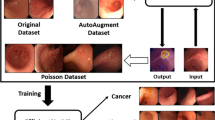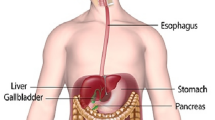Abstract
Endoscopy is being the most extensively used diagnostic tool for treatment of organs inside humans. However, many challenges exist that are faced by doctors (endoscopists) including: visual interpretation difficulty because of objects, problems in the identification of cancer abnormalities, and pre-cancerous precursors. In this research paper, an analysis has been performed for classification of diseases such as: non-dysplastic Barrett’s esophagus (BE), subtle pre-cancerous lesion (suspicious), suspected dysplasia (HGD), adenocarcinoma (cancer), and polyp approach using ML and DL. Firstly, machine learning using AI is implemented on the dataset to train the model, but the model is not trained properly because the lesser number of images are used for training the model. Therefore, to ensure higher accuracy, image augmentation is applied on the given dataset of images so that number of images used to train the model can be increased. Here, a tremendous improvement can be vividly seen, but to further improve the accuracy, the augmentation and DL are amalgamated together and the comparison is then made with the existing ML-based augmentation approach. The outcome of DL with augmentation seems to dominate ML-based augmentation. As the epoch’s value keeps on incrementing, the accuracy percentage also increases. Various transfer learning methods show higher accuracy in DL-based augmentation approach.
Access this chapter
Tax calculation will be finalised at checkout
Purchases are for personal use only
Similar content being viewed by others
References
Mendel R et al (2017) Barrett’s esophagus analysis using convolutional neural networks. In: Image Processing for Medicine. Springer, pp 80–85
Mori Y, Berzin TM, Shin-ei K (2019) Artificial intelligence for early gastric cancer: early promise and the path ahead. Gastrointest Endosc 89(4):816–817
Min JK, Kwak MS, Cha JM (2019) Overview of deep learning in gastrointestinal endoscopy. Gut Liver 13(4):388–393
Bernal J et al (2017) Comparative validation of polyp detection methods in video colonoscopy: results from the MICCAI 2015 endoscopic vision challenge. IEEE Trans Med Imaging 36(6):1231–1249. https://doi.org/10.1109/TMI.2017.2664042
Ali S, Zhou F, Bailey A, Braden B, East JE, Lu X, Rittscher J (2021) A deep learning framework for quality assessment and restoration in video endoscopy. Med Image Anal 68:101900. https://doi.org/10.1016/j.media.2020.101900
Yuan Y, Li B, Meng MQ-H (2017) WCE abnormality detection based on saliency and adaptive locality-constrained linear coding. IEEE Trans Autom Sci Eng 14(1):149–159
Yuan Y, Li B, Meng MQ-H (2016) Bleeding frame and region detection in the wireless capsule endoscopy video. IEEE J Biomed Health Inform 20(2):624–630
Yuan Y, Yao X, Han J, Guo L, Meng MQ-H (2017) Discriminative joint-feature topic model with dual constraints for WCE classification. IEEE Trans Cybern 48(7):2074–2085
Alizadeh M, Maghsoudi OH, Sharzehi K, Hemati HR, Asl AK, Talebpour A (2017) Detection of small bowel tumor in wireless capsule endoscopy images using an adaptive neuro-fuzzy inference system. J Biomed Res 33(5):419–427
Maghsoudi OH (2017) Superpixel based segmentation and classification of polyps in wireless capsule endoscopy. In: 2017 IEEE Signal processing in medicine and biology symposium (SPMB). IEEE, pp 1–4. https://doi.org/10.1109/SPMB.2017.8257027
Shin H-C et al (2016) Deep convolutional neural networks for computer-aided detection: CNN architectures, dataset characteristics and transfer learning. IEEE Trans Med Imag 35(5):1285–1298
Christodoulidis S, Anthimopoulos M, Ebner L, Christe A, Mougiakakou S (2017) Multisource transfer learning with convolutional neural networks for lung pattern analysis. IEEE J Biomed Health Inform 21(1):76–84
Zhang W et al (2015) Deep convolutional neural networks for multi-modality isointense infant brain image segmentation. Neuroimage 108:214–224
Tajbakhsh N et al (2016) Convolutional neural networks for medical image analysis: full training or fine tuning?’. IEEE Trans Med Imag 35(5):1299–1312
Rezvy S et al (2020) Transfer learning for endoscopy disease detection and segmentation with mask-RCNN benchmark architecture. In: Proceedings of the 2nd International workshop and challenge on computer vision in endoscopy, EndoCV@ISBI 2020, Iowa City, Iowa, USA, vol 2595 of CEUR Workshop Proceedings CEUR-WS.org, pp 68–72
Ali S et al (2020) Endoscopy disease detection and segmentation (EDD2020). IEEE Data Port. https://dx.doi.org/10.21227/f8xg-wb80.s. Accessed on 14-May-2022
Author information
Authors and Affiliations
Corresponding author
Editor information
Editors and Affiliations
Rights and permissions
Copyright information
© 2023 The Author(s), under exclusive license to Springer Nature Singapore Pte Ltd.
About this paper
Cite this paper
Angurala, M., Khullar, V., Singh, P. (2023). Experimenting Transfer Learning and Machine Learning on Endoscopy Database with Augmentation. In: Rani, A., Kumar, B., Shrivastava, V., Bansal, R.C. (eds) Signals, Machines and Automation. SIGMA 2022. Lecture Notes in Electrical Engineering, vol 1023. Springer, Singapore. https://doi.org/10.1007/978-981-99-0969-8_68
Download citation
DOI: https://doi.org/10.1007/978-981-99-0969-8_68
Published:
Publisher Name: Springer, Singapore
Print ISBN: 978-981-99-0968-1
Online ISBN: 978-981-99-0969-8
eBook Packages: EnergyEnergy (R0)




